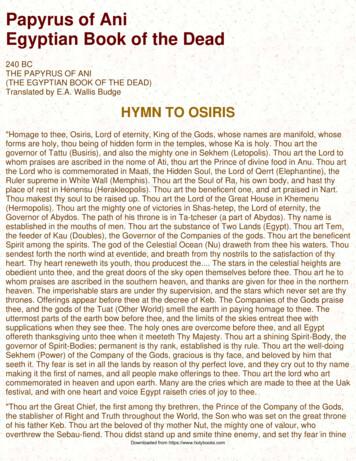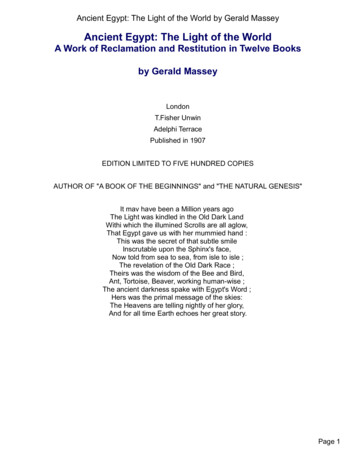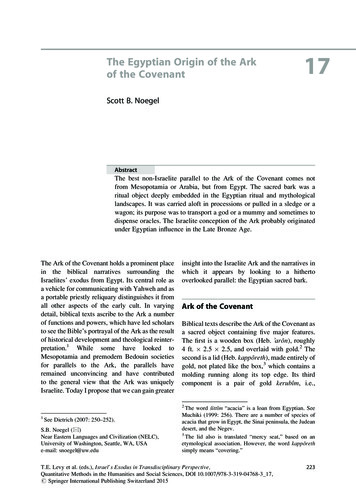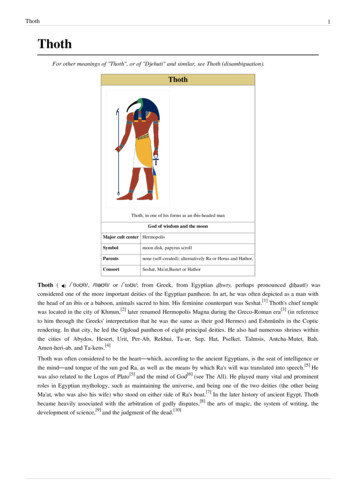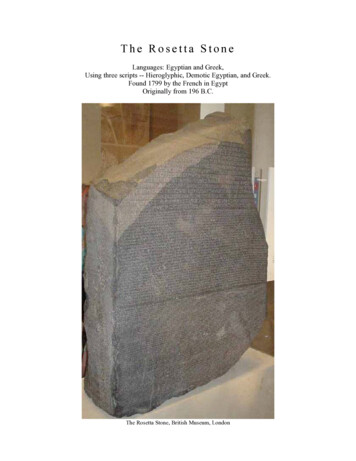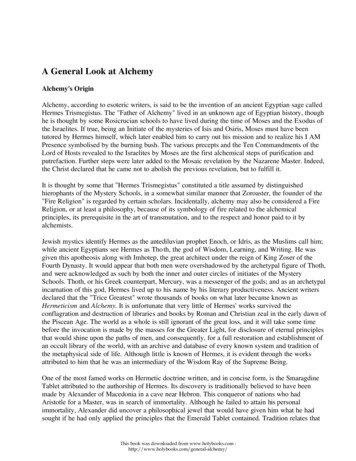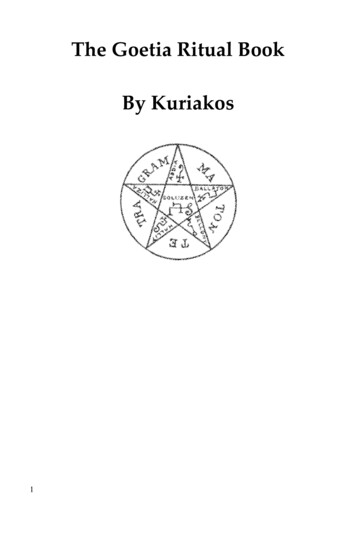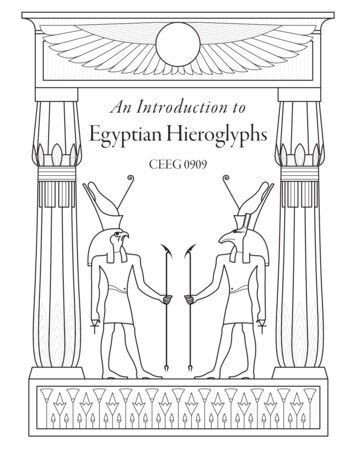
Transcription
An Introduction toEgyptian HieroglyphsCEEG 0909
A Workbook forAn Introduction to Egyptian HieroglyphsC. CaseyWilbour Hall 301christian casey@brown.eduApril 9, 2018ContentsSyllabusDay 337Day 33-I-1 Calligraphy Practice 3 – Multiliterals & Common Classifiers3-I-2 Vocabulary – Multiliterals & Classifiers . . . . . . . . . . .3-I-3 Vocabulary – Suffix Pronouns, Parts of the Body . . . . . .3-I-4 Parts of the Body . . . . . . . . . . . . . . . . . . . . . . .3-II-3 Homework – Suffix Pronouns & Parts of the Body . . . . .393943454748Rosetta Stone . . . . . . . . . . . . . .Calligraphy Practice 1 – Uniliterals . .Meet Your Classmates . . . . . . . . .The Begatitudes . . . . . . . . . . . .Vocabulary – Uniliterals & ClassifiersDay 22-I-1 Timeline of Egyptian Languages . .2-I-2 Calligraphy Practice 2 – Biliterals .2-I-3 Biliteral Chart . . . . . . . . . . . .2-I-4 Vocabulary – Biliterals & Classifiers2-II-3 Vocabulary – Household Objects . .Day 4494-I-1 Vocabulary – Articles, Independent Pronouns, Family, Deities . . . . . . . . . . . . . . . . . . . . . . 494-I-4 Gods and Goddesses . . . . . . . . . . . . . . . . . . . . . . . . . . . . . . . . . . . . . . . . . . . . . 544-II-2 Homework – Nominal Sentences . . . . . . . . . . . . . . . . . . . . . . . . . . . . . . . . . . . . . . 57Day 5595-I-1 Vocabulary – Geography . . . . . . . . . . . . . . . . . . . . . . . . . . . . . . . . . . . . . . . . . . . 595-I-4 The Book of the Dead . . . . . . . . . . . . . . . . . . . . . . . . . . . . . . . . . . . . . . . . . . . . 625-II-2 Homework – Adverbial Sentences . . . . . . . . . . . . . . . . . . . . . . . . . . . . . . . . . . . . . 63Day 6656-I-2 Vocabulary – Dependent Pronouns, Prepositions, Adverbs . . . . . . . . . . . . . . . . . . . . . . . . 656-II-2 Homework – Adjectives, Statives, Pseudoverbals . . . . . . . . . . . . . . . . . . . . . . . . . . . . . 701
Day 77-I-1 Vocabulary – Geography . . . . . . . . . . . . . . . . . . . .7-I-2 Map . . . . . . . . . . . . . . . . . . . . . . . . . . . . . . .7-I-3 Vocabulary – Particles & Conjunctions, Special Imperatives7-II-2 Homework – Imperatives, sdm.f s, Temporal Clauses . . . .7373767778Day 8828-I-1 Vocabulary – Relative Verbs & Second Tenses . . . . . . . . . . . . . . . . . . . . . . . . . . . . . . . 828-I-4 The Stela of Heni . . . . . . . . . . . . . . . . . . . . . . . . . . . . . . . . . . . . . . . . . . . . . . . 848-II-2 Homework – Relatives & Second Tenses . . . . . . . . . . . . . . . . . . . . . . . . . . . . . . . . . . 85Day 99-I-1 Vocabulary – Group Writing9-I-4-1 Wenamun Egyptian . . . .9-I-4-2 Wenamun Transliteration .9-I-4-3 Wenamun Translation . . .9-I-4-4 Wenamun Glossary . . . . .2.87. 87. 89. 97. 105. 113
Syllabus3
Class Meeting Time/PlaceDate:Time:Place:July 9–13, July 16–20, 20188:30 – 11:20Wilbour Hall 301Office HoursDate:Time:Place:July 9–13, July 16–20, 201812:00 – 14:00Wilbour Hall 304Course DescriptionEgyptian has the longest written history of any language, with surviving texts spanning four millennia, fromapproximately 3200 BC to at least 1100 AD. However, knowledge of this ancient language was lost until thediscovery of the Rosetta Stone in 1799 AD. There are no longer any native speakers of Egyptian, and the languagecan only be studied through an imperfectly-understood script. Despite these shortcomings, Egyptologists havemade great headway in understanding this once incomprehensible script and the language it ultimately represents.One of the greatest barriers to learning the hieroglyphs is their lack of connection to a spoken language. Egyptologists generally work with an artificial reconstruction of the language which bears little similarity to actual spokenEgyptian. This scholarly form of Egyptian is difficult to understand for new students, especially those who lackexperience with advanced studies of philology, phonetics, and syntax. However, thanks to new information aboutpronunciation and grammar preserved in later Coptic texts, which is still being developed through ongoing research,it is possible to teach Egyptian with a deliberate focus on what we do know about the spoken language.In keeping with this aim, this course will teach the most recent stage of Egyptian that was written using thehieroglyphic script: Late Egyptian. This method will enable students to learn the hieroglyphic script throughthe medium of a language that they can practice by speaking aloud. The goal behind this approach, which issupported by extensive scientific research in the field of second-language acquisition, is to create an introductionto Egyptian which provides the best foundation for long-term study, and which communicates the crucial messagethat Hieroglyphic script represents a real language, which was once spoken by real people who lived lives that werenot entirely different from ours.Course ObjectivesBy the end of the course, students will be able to read Late Egyptian stories similar to those studied in class. Theywill also be able to read some inscriptions, such as those found in many art museums across the United States. Theywill have a broad understanding of the history of the Egyptian language, and they will be well prepared to begina serious study of Egyptian at the undergraduate level. Students will also develop a familiarity with the resourcesavailable to them so that they can continue their studies on their own if they wish.Course RequirementsPrerequisitesThis course requires some knowledge of English grammar so that parallel concepts in Egyptian can be introducedquickly. For those students who do not have a thorough grasp of English grammar, supplementary readings willbe provided from the book English Grammar Guide for Language Students. This book, which is required for thecourse, is designed to fill gaps in grammatical knowledge for new students of ancient languages.Assignments and ReadingsMost assignments and readings will be handed out in hard copy in class. All will also be posted on the Canvaswebsite so that they can be accessed electronically at any time. Quizzes and exams will not be on Canvas, but theywill be made available online after the end of the course.4
MaterialsIn addition to the usual basic school supplies (notebook and pencils), students will also be required to bringindex cards ( 200). These will be used to make flashcards for studying signs and vocabulary outside of class.However, students may also download the Anki app (https://apps.ankiweb.net), which will enable them to downloadshared decks to study on laptops and phones. (N.B. The browser and desktop versions are free. The mobileversion is not, but it is well worth the price. There are shared decks for a huge variety of subjects, and you canuse this app for the rest of the time you’re in school.) The shared deck for this course is available online eworkAttendance & ParticipationAttending class and participating in group activities are mandatory and represent a significant portion of yourtotal evaluation for this course. Some of the in-class activities are designed to encourage collaboration with otherstudents, and students will be expected to work together. Students who have difficulty with class participationshould discuss this with the instructor so that special accommodations can be made. Any discussions will be keptconfidential.HomeworkEach day, beginning with the first class, students will be asked to complete a homework assignment to practice acrucial skill learned that day. This is necessary because subsequent classes assume a thorough knowledge of theprevious day’s most important topics.QuizzesBeginning with the second day of class, there will be daily quizzes on vocabulary and grammar. The quizzes willbe largely diagnostic. Their primary purpose is to allow me to update the lessons to reflect the specific needs ofthis class, but they will still be graded. All together they only make up 10% of the final score for the course.Final ExamOn Friday, July 20, students will take a final exam covering the material from the literature reading.Final ProjectFor their final project, students will compose an original text in Ancient Egyptian and write it on papyrus like areal Egyptian scribe. Students will be allowed to take the second project home as a souvenir.GradingAttendance & ParticipationHomeworkQuizesFinal ExamFinal Project20%20%10%25%25%Course CalendarEach day is divided into three parts:I. In-Class ActivitiesII. HomeworkIII. Reading5
Week 1Monday, July 9Class 1 – I. In-Class Activities Rosetta Stone– Using royal names from the Rosetta Stone (and elsewhere), decipher some basic Egyptian phonograms,just as Thomas Young did in the early 1800s. Calligraphy Practice 1 – Uniliterals– Learn to write the uniliteral hieroglyphs as an Egyptian scribe would have. Your Name in Hieroglyphs– Make a nametag Using the uniliteral signs learned in the previous activity, make a nametag for yourself in the hieroglyphic script.– Meet your Classmates Use these nametags to learn your classmates’ names and introduce yourself. The Begatitudes– Using the names found in the Genealogy of Jesus from Matthew, decipher the Coptic script. We will useCoptic throughout the course to reconstruct the pronunciations of Egyptian words. Vocabulary – Uniliterals & ClassifiersClass 1 – II. Homework Practice sign calligraphy. Make flashcards for the words we learned in class and study them.Class 1 – III. Reading Allen, 2014, pp. 1-12 – The History of the Egyptian Language. Burton, pp. 23-47, 97-100 (Parts of Speech)Tuesday, July 10Class 2 – I. In-Class Activities Quiz – Uniliteral Vocabulary Quiz – Coptic Orthography Quiz – Parts of Speech Timeline– Design a timeline that shows the development of Egyptian over its long history based on what you learnedin last night’s reading.– In groups, combine your individual ideas to make a large timeline to hang on the wall. Calligraphy Practice 2 – Biliterals– Learn to write the biliteral hieroglyphs as an Egyptian scribe would have. Vocabulary – Biliterals & Classifiers6
Class 2 – II. Homework Practice sign calligraphy. Make flashcards for the words we learned in class and study them. Label household objects.Class 2 – III. Reading Depuydt, 1993, pp. 1-5 Burton, pp. 111-132 (Person, Number, Gender, Agreement, Pronouns)Wednesday, July 11Class 3 – I. In-Class Activities Quiz – Biliteral Vocabulary Quiz – Person, Number, & Gender Calligraphy Practice 3 – Multiliterals & Common Classifiers– Learn to write the multiliteral hieroglyphs as an Egyptian scribe would have. Vocabulary – Multiliterals & Classifiers Vocabulary – Suffix Pronouns & Parts of the Body Parts of the Body– Label the figure in your workbook in both hieroglyphs and Coptic.– In groups, label the poster-sized figure to hang on the wall. Grammar – Suffix Pronouns– Practice creating possessive noun phrases using the printed cards.– Test your partner by inventing new combinations.Class 3 – II. Homework Practice sign calligraphy. Make flashcards for the words we learned in class and study them. Complete the Suffix Pronoun activity in your workbook.Class 3 – III. Reading Pinch, 2004, figs. 2a-b, pp. 30-53 Burton, pp. 5-22 (Subject and Predicate)7
Thursday, July 12Class 4 – I. In-Class Activities Quiz – Multiliteral Vocabulary Quiz – Suffix Pronouns Quiz – Subject and Predicate Vocabulary – Articles, Independent Pronouns, Family, Gods & Goddesses Grammar – Possessive Articles– Practice creating noun phrases using the printed cards.– Test your partner by inventing new combinations. Grammar – Nominal Sentences– Practice creating nominal sentences using the printed cards.– Test your partner by inventing new combinations. Gods & Goddesses– Label the figures in your workbook in both hieroglyphs and Coptic. Divine Family Tree– Label the Ennead in your workbook in both hieroglyphs and Coptic.– In groups, label the Ennead poster to hang on the wall.– Use nominal sentences to describe the relationships between deities.Class 4 – II. Homework Make flashcards for the words we learned in class and study them. Complete the Nominal Sentences activity in your workbook.Class 4 – III. Reading Watch ”The Egyptian Book of the Dead” documentary (in Canvas) Burton, pp. 49-64 (Copular Sentences)Friday, July 13Class 5 – I. In-Class Activities Quiz – Gods and Nouns Quiz – Articles and Nominal Sentences Quiz – Objects, Stative, Copula Vocabulary – Prepositions, Adverbs Grammar – Prepositional Phrases– Practice creating prepositional phrases using the printed cards (both from today and yesterday).– Test your partner by inventing new combinations. Grammar – Adverbial Sentences– Practice creating adverbial sentences using the printed cards.8
– Test your partner by inventing new combinations. The Book of the Dead– Read the text in the workbook on your own.– Discuss the text with the class. Hay Library– We will take a short field trip to the Hay library, where we will view the mysterious and esoteric ancientpapyri in Brown’s collection.Class 5 – II. Homework Make flashcards for the words we learned in class and study them. Complete the Adverbial Sentences activity in your workbook.Class 5 – III. Reading The Misadventures of Wenamun (comic book). Burton, pp. 133-153 (Non-finite Verbs), 163-169 (Adj. Phrases)Week 2Monday, July 16Class 6 – I. In-Class Activities Quiz – All vocabulary Quiz – Verbs and Adjectives Discuss The Misadventures of Wenamun together as a class. Vocabulary – Dependent Pronouns, Adjectives, Verbs Grammar – Adjectives Grammar – Statives Grammar – Pseudoverbal Sentences– Practice creating pseudoverbal sentences using the printed cards.– Test your partner by inventing new combinations. Writing Materials and Technology– Make your own Egyptian papyrus and ink from raw materialsClass 6 – II. Homework Make flashcards for the words we learned in class and study them. Complete the Adjectives, Statives, Pseudoverbals activity in your workbook.Class 6 – III. Reading Manley, 1996, pp. 70-73, 94-95, 98-99 (Egyptian geography during the Third Intermediate Period) Gilboa, 2015 Burton, pp. 67-96 (Verbs)9
Tuesday, July 17Class 7 – I. In-Class Activities Quiz – Adjectives, Verbs Quiz – Verbs Vocabulary – Geography Create a map of Ancient Egypt and the Eastern Mediterranean– Using the Atlas of Ancient Egypt (part of which you read yesterday) locate places from the list ofgeographical nouns on your own map.– In groups, use your individual maps to label a large map to hang on the wall. Vocabulary – Particles, Imperatives Grammar – Imperatives Grammar – sdm.f ’s Grammar – Conjunctives, Temporals, TerminativesClass 7 – II. Homework Make flashcards for the words we learned in class and study them. Complete the Imperative, sdm.f ’s, Temporal Clauses activity in your workbook.Class 7 – III. Reading Simpson, 2003– Allen, The Stela of Heni Burton, pp. 171-188 (Clauses)Wednesday, July 18Class 8 – I. In-Class Activities Quiz – Geography Quiz – Clauses Vocabulary – Relative Verbs Grammar – Relative Verbs Grammar – Second Tenses The Steal of Heni– Read the text in the workbook on your own.– Discuss the text with the class. Gods & Tombs– We will take a short field trip to the RISD Museum, where we will read inscriptions and see an Egyptiangod incarnate.Class 8 – II. Homework Make flashcards for the words we learned in class and study them. Complete the Relatives & Second Tenses activity in your workbook.10
Class 8 – III. Reading Junge, 2001, pp. 41-45 – Group WritingThursday, July 19Class 9 – I. In-Class Activities Quiz – Relative Verbs Vocabulary – Group Writing Grammar – Group Writing Grammar – Converters Wenamun– Together as a class we will read the entire story, which is included in your workbook. Speech Bubbles– Select lines from the hieroglyphic story to write into large frames from the comic book to decorate theroom.Class 9 – II. Homework Make flashcards for the words we learned in class and study them. Reread and study the Wenamun story in Egyptian.Class 9 – III. Reading Sass, 2002Friday, July 20Class 10 – I. In-Class Activities Exam – Literature Wenamun– Discuss the entire story and any grammatical difficulties that you discovered during your studying. Final Project – Create your own Egyptian text– Prepare composition in English and discuss with teacher.– Learn vocabulary needed to produce Egyptian text.– Identify any new hieroglyphs in the vocabulary and learn to draw them.– Work out grammar of text and implement Egyptian version.– Draw text with cursive hieroglyphs on papyrus in the style of an Egyptian funerary text.– Read your text aloud to your classmates (optional).11
Day 112
1-I-1Rosetta StoneRosetta StoneDetermine the sounds of these hieroglyphs 𓄿𓇋𓇋𓇋𓅱𓏲𓍯𓊪𓅓 𓐝 𓈖 𓂋 𓃭 𓊃𓋴𓈙𓈎 using the names of these famous kings who once ruled Egypt:PsamtekDarius (Duriush)Alexander (Aleksandros)AutocratorCaesar (Kaisaros)CleopatraPtolemy (Ptolemaios)13𓎡𓎼𓏏𓍿 𓂧
1-I-2Calligraphy Practice 1 – UniliteralsCalligraphy Practice 1 – UniliteralsWrite the phonetic values of the uniliteral hieroglyphs and practice drawing/writingthem in the space 𓇋𓇋𓂝𓅱𓏲14
1-I-2Calligraphy Practice 1 – �15
1-I-2Calligraphy Practice 1 – �𓂧𓆓16
1-I-4Meet Your ClassmatesMeet Your ClassmatesGo around the room and learn everyone’s name using only their nametag (andmaybe the occasional hint). Find out where they are from and at least oneinteresting fact about them.NameHomeFun Fact17
1-I-5The BegatitudesSelections from Matthew 1:1-16 – The “Begatitudes”Part 1: Determine the sounds of the Coptic alphabet using the text below.Tips: Do not assume that the letters have the values of the letters they resemble in the Latinalphabet (some do, many don’t).Note that some letters represent multiple sounds (e.g. x ks), and some sounds are representedby a combination of two letters (e.g. sh ʃ).Do not hunt for letters from this list individually. Read the text and figure out the truerelationships between sound and symbol.ⲝ ⲥ ⲁ ⲉ ϯ ⲃ ⲣ ⲭ ⲏ ϣ ⲉⲓ ⲑ ⲍ ⲩ ⲟⲩ ϫ ⲓ ⲯ ϩ ⲙ ⲡ ϭ ⲕ ⲛ ⲱ ⲇ ⲗ ϧ ⲫ ⲧ ⲟ ϥ ⲅksshdypskyEvidence:EnglishSaidic CopticBohairic CopticThe book of the generationof Jesus Christ, the son ofDavid, the son of Abraham.ⲡϫⲱⲱⲙⲉ ⲙⲡⲉϫⲡⲟ ⲛⲓⲏⲥⲟⲩⲥⲡⲉⲭⲣⲓⲥⲧⲟⲥ ⲡϣⲏⲣⲉ ⲛⲇⲁⲩⲉⲓⲇⲡϣⲏⲣⲉ ⲛⲁⲃⲣⲁϩⲁⲙ.ⲡϫⲱⲙ ⲙⲙⲓⲥⲓ � ⲡϣⲏⲣⲓ ⲛⲇⲁⲩⲓⲇⲡϣⲏⲣⲓ ⲛⲁⲃⲣⲁⲁⲙ.Abraham begat Isaac; andIsaac begat Jacob; and Jacobbegat Judas and hisbrethren;ⲁⲃⲣⲁϩⲁⲙ ⲁϥϫⲡⲟ ⲛⲓⲥⲁⲁⲕⲓⲥⲁⲁⲕ ⲇⲉ ⲁϥϫⲡⲟ ⲛⲓⲁⲕⲱⲃⲓⲁⲕⲱⲃ ⲇⲉ ⲁϥϫⲡⲟ ⲛⲓⲟⲩⲇⲁⲥ ⲙⲛⲛⲉϥⲥⲛⲏⲩ.ⲁⲃⲣⲁⲁⲙ ⲇⲉ ⲁϥϫⲫⲉ ⲓⲥⲁⲁⲕⲓⲥⲁⲁⲕ ⲇⲉ ⲁϥϫⲫⲉ ⲓⲁⲕⲱⲃⲓⲁⲕⲱⲃ ⲇⲉ ⲁϥϫⲫⲉ ⲓⲟⲩⲇⲁⲥ ⲛⲉⲙⲛⲉϥⲥⲛⲏⲟⲩ.And Judas begat Phares andZara of Thamar; and Pharesbegat Esrom; and Esrombegat Aram;ⲓⲟⲩⲇⲁⲥ ⲇⲉ ⲁϥϫⲡⲟ ⲙⲫⲁⲣⲉⲥ ⲙⲛⲍⲁⲣⲁ ⲉⲃⲟⲗ ϩⲛ ⲑⲁⲙⲁⲣ ⲫⲁⲣⲉⲥⲇⲉ ⲁϥϫⲡⲟ ⲛⲉⲥⲣⲱⲙ. ⲉⲥⲣⲱⲙ ⲇⲉⲁϥϫⲡⲟ ⲛⲁⲣⲁⲙ.ⲓⲟⲩⲇⲁⲥ ⲇⲉ ⲁϥϫⲫⲉ ⲫⲁⲣⲉⲥ ⲛⲉⲙⲍⲁⲣⲁ ⲉⲃⲟⲗ ϧⲉⲛⲑⲁⲙⲁⲣ ⲫⲁⲣⲉⲥⲇⲉ ⲁϥϫⲫⲉ ⲉⲥⲣⲱⲙ. ⲉⲥⲣⲱⲙ ⲇⲉⲁϥϫⲫⲉ ⲁⲣⲁⲙ.And Salmon begat Booz ofRachab; and Booz begatObed of Ruth; and Obedbegat Jesse;ⲥⲁⲗⲙⲱⲛ ⲇⲉ ⲁϥϫⲡⲟ ⲛⲃⲟⲉⲥⲉⲃⲟⲗ ϩⲛ ϩⲣⲁⲭⲁⲃ. ⲃⲟⲉⲥ ⲇⲉⲁϥϫⲡⲟ ⲛⲓⲱⲃⲏⲇ ⲉⲃⲟⲗ ϩⲛϩⲣⲟⲩⲑ. ⲓⲱⲃⲏⲇ ⲇⲉ ⲛ ⲇⲉ ⲁϥϫⲫⲉ ⲃⲟⲉⲥⲉⲃⲟⲗ ϧⲉⲛⲣⲏⲭⲁⲃ ⲃⲟⲉⲥ ⲇⲉⲁϥϫⲫⲉ ⲓⲟⲩⲃⲏⲇ ⲓⲟⲩⲃⲏⲇ ⲇⲉⲁϥϫⲫⲉ ⲓⲉⲥⲥⲉ.18f
1-I-5The BegatitudesAnd Jesse begat David theking; and David the kingbegat Solomon of her thathad been the wife of Urias;ⲓⲉⲥⲥⲁⲓ ⲇⲉ ⲁϥϫⲡⲟ ⲛⲇⲁⲩⲉⲓⲇⲡⲣⲣⲟ. ⲇⲁⲩⲉⲓⲇ ⲇⲉ ⲁϥϫⲡⲟⲛⲥⲟⲗⲟⲙⲱⲛ ⲉⲃⲟⲗ ϩⲛ ⲑⲓⲙⲉⲛⲟⲩⲣⲓⲁⲥ.ⲓⲉⲥⲥⲉ ⲇⲉ ⲁϥϫⲫⲉ ⲇⲁⲩⲓⲇⲇⲁⲩⲓⲇ ⲇⲉ ⲁϥϫⲫⲉ ⲥⲟⲗⲟⲙⲱⲛⲉⲃⲟⲗ ϧⲉⲛⲑⲁ ⲟⲩⲣⲓⲁⲥ.And Solomon begatRoboam; and Roboam begatAbia; and Abia begat Asa;ⲥⲟⲗⲟⲙⲱⲛ ⲇⲉ ⲁϥϫⲡⲟⲛϩⲣⲟⲃⲟⲁⲙ ϩⲣⲟⲃⲟⲁⲙ ⲇⲉⲁϥϫⲡⲟ ⲛⲁⲃⲓⲁ ⲁⲃⲓⲁⲥ ⲇⲉⲁϥϫⲡⲟ ⲛⲁⲥⲁⲫ.ⲥⲟⲗⲟⲙⲱⲛ ⲇⲉ ⲁϥϫⲫⲉ ⲣⲟⲃⲟⲁⲙⲣⲟⲃⲟⲁⲙ ⲇⲉ ⲁϥϫⲫⲉ ⲁⲃⲓⲁ ⲁⲃⲓⲁⲇⲉ ⲁϥϫⲫⲉ ⲁⲥⲁⲫ.And Ozias begat Joatham;and Joatham begat Achaz;and Achaz begat Ezekias;ⲟⲍⲉⲓⲁⲥ ⲇⲉ ⲁϥϫⲡⲟ ⲛⲓⲱⲁⲑⲁⲙ.ⲓⲱⲛⲁⲑⲁⲙ ⲇⲉ ⲁϥϫⲡⲟ ⲛⲁⲭⲁⲍⲁⲭⲁⲍ ⲇⲉ ⲁϥϫⲡⲟ ⲛⲉⲍⲉⲕⲉⲓⲁⲥ.ⲟⲍⲓⲁⲥ ⲇⲉ ⲁϥϫⲫⲉ ⲓⲱⲁⲑⲁⲙⲓⲱⲁⲑⲁⲙ ⲇⲉ ⲁϥϫⲫⲉ ⲁⲭⲁⲍⲁⲭⲁⲍ ⲇⲉ ⲁϥϫⲫⲉ ⲉⲍⲉⲕⲓⲁⲥ.And Ezekias begatManasses; and Manassesbegat Amon; and Amonbegat Josias;ⲉⲍⲉⲕⲉⲓⲁⲥ ⲇⲉ ⲁϥϫⲡⲟⲙⲙⲁⲛⲁⲥⲥⲏ ⲙⲁⲛⲁⲥⲥⲏ ⲇⲉⲁϥϫⲡⲟ ⲛϩⲁⲙⲱⲥ. ϩⲁⲙⲱⲥ ⲇⲉⲁϥϫⲡⲟ ⲛⲓⲱⲥⲓⲁⲥ.ⲉⲍⲉⲕⲓⲁⲥ ⲇⲉ ⲁϥϫⲫⲉ ⲙⲁⲛⲁⲥⲥⲏⲙⲁⲛⲁⲥⲥⲏ ⲇⲉ ⲁϥϫⲫⲉ ⲁⲙⲱⲥⲁⲙⲱⲥ ⲇⲉ ⲁϥϫⲫⲉ ⲓⲱⲥⲓⲁⲥ.And Josias begat Jechoniasand his brethren, about thetime they were carried awayto Babylon:ⲓⲱⲥⲓⲁⲥ ⲇⲉ ⲁϥϫⲡⲟ ⲛⲓⲉⲭⲟⲛⲓⲁⲥⲙⲛ ⲛⲉϥⲥⲛⲏⲩ ϩⲓ ⲡⲡⲱⲱⲛⲉ ��ⲁⲥ ⲇⲉ ⲁϥϫⲫⲉ ⲓⲉⲭⲟⲛⲓⲁⲥⲛⲉⲙ ⲛⲉϥⲥⲛⲏⲟⲩ ϩⲓ ⲡⲓⲟⲩⲱⲧⲉⲃⲉⲃⲟⲗ ⲛⲧⲉⲃⲁⲃⲩⲗⲱⲛ.And after they were broughtto Babylon, Jechonias begatSalathiel; and Salathiel begatZorobabel;ⲙⲛⲛⲥⲁ ⲡⲡⲱⲱⲛⲉ ⲇⲉ ⲉⲃⲟⲗⲛⲧⲃⲁⲃⲩⲗⲱⲛ ⲓⲉⲭⲟⲛⲓⲁⲥ ⲁϥϫⲡⲟⲛⲥⲁⲗⲁⲑⲓⲏⲗ ⲥⲁⲗⲁⲑⲓⲏⲗ ⲇⲉⲁϥϫⲡⲟ �� ⲡⲓⲟⲩⲱⲧⲉⲃ ⲉⲃⲟⲗⲛⲧⲉⲃⲁⲃⲩⲗⲱⲛ ⲓⲉⲭⲟⲛⲓⲁⲥⲁϥϫⲫⲉ ⲥⲁⲗⲁⲑⲓⲏⲗ ⲥⲁⲗⲁⲑⲓⲏⲗⲇⲉ ⲁϥϫⲫⲉ ⲍⲟⲣⲟⲃⲁⲃⲉⲗ.And Jacob begat Joseph thehusband of Mary, of whomwas born Jesus, who is calledChrist.ⲓⲁⲕⲱⲃ ⲇⲉ ⲁϥϫⲡⲟ ⲛⲓⲱⲥⲏⲫⲡϩⲁⲓ ⲙⲙⲁⲣⲓⲁ. ⲧⲁⲓ ⲛⲧⲁⲩϫⲡⲉⲓⲏⲥⲟⲩⲥ ⲉⲃⲟⲗ ⲛϩⲏⲧⲥ. ⲡⲁⲓⲛϣⲁⲩⲙⲟⲩⲧⲉ ⲉⲣⲟϥ ϫⲉⲡⲉⲭⲣⲓⲥⲧⲟⲥ.ⲓⲁⲕⲱⲃ ⲇⲉ ⲁϥϫⲫⲉ ⲓⲱⲥⲏⲫ ⲡϩⲁⲓⲙⲙⲁⲣⲓⲁ ⲑⲏ ⲉⲧⲁⲥⲙⲉⲥ ⲓⲏⲥⲟⲩⲥⲫⲏ ⲉⲧⲟⲩⲙⲟⲩϯ ⲉⲣⲟϥ ϫⲉⲡⲭⲣⲓⲥⲧⲟⲥ.Part 2: Write the complete Coptic alphabet together as a class:19
1-I-6Vocabulary – Uniliterals & ClassifiersVocabulary – Uniliterals & ClassifiersTranscribe the following words.N.B. The Coptic can help you figure things out, but it doesn't match ���𓄿𓊪𓂧𓅬Englishtranslatorⲱⲃⲧduck, k𓄿𓏏𓊪𓀋ⲱⲧⲡto �ⲟϩmoon𓇋𓅱ⲉ (circumstantial �ⲙⲁ-give, cause (imp.)𓇋𓅓𓋴𓏏ⲙⲙⲟⲥin it ��ⲛⲉstone𓇋𓂋𓇋𓂋𓊪𓏊as for ableⲁϣwhat?20
1-I-6Vocabulary – Uniliterals & �ⲟⲗⲉto 𓈙𓏲𓀁ⲱϣto read, ���sacred barque𓅱𓂝𓂋𓏲𓂾𓂻to �ⲉfishermen𓅱𓈙𓃀𓀁ⲟⲩⲱϣⲃto 𓅄ⲃⲏϭfalcon𓃀𓈖ⲛnot (neg. particle)21
1-I-6Vocabulary – Uniliterals & Classifiers𓊪𓏏𓇯ⲡⲉsky, heaven𓆑𓄿𓇋𓇋𓀋ϥⲁⲓraise, lift up, �ⲛⲧworm𓅓ⲙin, with, from𓅓𓂋ⲗⲉ-overseer𓅓𓂋𓂝𓏤also, likewise𓅓𓂝𓈖𓏥𓂜ⲙⲙⲟⲛthere is not𓅓𓈖𓏏𓏲𓏥ⲛⲧⲟⲟⲩthey (3cp ind. pron.)𓅓𓈖𓏏𓆑ⲛⲧⲟϥhe (3ms ind. pron.)𓅓𓈖𓏏𓎡ⲛⲧⲟⲕyou (2ms ind. ��ⲙⲟⲩto die𓅓𓏏𓏱ⲙⲟⲩto die𓅓𓏏𓏲𓆑ⲛϥ-and he (3ms conj.)𓅓𓏏𓏲𓏏𓈖𓏥ⲛⲧⲉⲧⲛ-and y'all (2cp ���𓇋𓏥𓎡ⲛⲉⲕ-your (2ms p. def. art.)𓈖𓇋𓅓ⲙⲉⲛ/ⲛⲙⲙⲁ with22
1-I-6Vocabulary – Uniliterals & Classifiers𓈖𓏲𓏥ⲛⲁⲩfor them (3cp)𓈖𓆑ⲛⲁϥfor �ⲉⲛ some (p. indef. art.)𓈖𓏏𓏭ⲛⲧwho, 𓂋𓏲𓇋𓄿𓂢𓂻ⲗⲟto get out𓂋𓅓𓏲𓁿𓀁ⲣⲓⲙⲉto ame𓂋𓐍𓏭𓏛-ϣ-to know𓂋𓈙𓏲𓏏𓇋𓂊𓏛ⲣⲁϣⲉto 𓂻ϩⲁⲓto go 𓂻ϩⲱⲃto �ⲱ body, ���ϩⲙⲟⲟⲥto occupy (a ���ϩⲕⲟto be hungry23
1-I-6Vocabulary – Uniliterals & Classifiers𓎛𓈎𓂋𓀁ϩⲕⲟto be hungry𓐍𓊪𓂋𓆣ϣⲱⲡⲉto occur, to ϩⲱⲧⲃto 𓊪𓊗to be �𓂝𓂧𓌫𓂡ϣⲱⲧto ⲏϣⲉmigratory bird𓏏𓄿ⲧ the (f.)𓏏𓄿𓏭ⲧⲁⲓthis (f.)𓏏𓄿𓇋𓇋𓆑ⲧⲉϥ-his (3ms) (f.)𓏏𓄿𓇋𓇋𓎡ⲧⲉⲕ-your (2ms) ���𓏏𓏭𓋸ⲧⲟⲟⲩⲉshoes24
1-I-6Vocabulary – Uniliterals & ��𓎛𓏏𓏭𓈓ⲧⲁϩⲧlead ���𓂋𓅟ⲧⲱⲣϣred𓂧𓈙𓂋𓏏𓈉the Red Land, ���𓈓ⲧⲁϩⲧlead (metal)𓆓𓂧ϫⲱto say𓆓𓂧𓎛𓂊𓉐to arrest25
Day 226
2-I-1TimelineTimeline of Egyptian LanguagesPart 1: Create your own timeline below based on the information in the reading. You may use whatever scale you think best captures the information. Try to include as much information as you can.27
2-I-2Calligraphy Practice 2 – BiliteralsCalligraphy Practice 2 – BiliteralsTogether in class, write the phonetic values of the hieroglyphs. Then practicewriting them in the space 𓂻𓃛𓄣𓐝𓏎𓁹𓃒𓇩𓉻𓅧𓍯28
2-I-2Calligraphy Practice 2 – 𓉐𓄖𓌔𓌳𓏇𓂟𓈗𓏠𓌻29
2-I-2Calligraphy Practice 2 – 𓃭𓂾𓇉𓎱𓈞𓆰𓁷𓎿30
2-I-2Calligraphy Practice 2 – 𓎝𓊨𓆷𓈝𓍱𓍢𓄞𓌟𓂓31
2-I-2Calligraphy Practice 2 – 𓋭𓂞𓁶𓍑𓈋𓇥𓊽32
2-I-3Biliteral ��𓅮n--o𓅧𓅯𓌳-s𓁶𓈋𓇥33𓊽
2-I-4Vocabulary – Biliterals & ClassifiersVocabulary – Biliterals & ClassifiersTranscribe the following words.N.B. The Coptic can help you figure things out, but it doesn't match ���ⲉⲓto come𓂻𓏲𓂻-ⲏⲩto �ⲉⲓⲛⲉto bring𓇋𓏌𓎡𓀀ⲁⲛⲟⲕI (1cs ind. pron.)𓁹𓂋𓏭ⲉⲓⲣⲉto reat𓂝𓌳𓄿𓅓𓁺𓏥ⲉⲓⲙⲉto understand𓍯𓄿𓆷𓄿𓏴𓂡to �ⲟⲩⲉⲓ/ⲟⲩ-one𓃹𓈖𓏲ⲟⲩⲛ-to �ⲛWenamun𓃹𓈖𓈖𓏭ⲛⲉ-(particle)34
2-I-4Vocabulary – Biliterals & Classifiers𓀘chief𓅨𓂋ⲟⲩⲏⲣhow 𓄞𓂧𓏭𓀢𓀁ⲟⲩⲱϣⲧto worship𓎘𓏲𓏭𓂻ⲟⲩⲱⲱⲧⲉto send𓅱𓍑𓄿𓏭𓏛ⲟⲩϫⲁⲓto be safe𓅡𓎡𓇋𓀀ⲃⲱⲕservant𓅯𓄿ⲡ the (m.)𓅯𓄿𓏭ⲡⲁⲓthis �ⲓⲣⲉto go 𓆵𓁺ⲡⲱⲱⲣⲉto look at𓅓𓁹ⲙⲡⲣ-do not (neg. h𓅓𓇥𓂋ⲛⲧⲉⲣⲉ ⲁϩⲉto seize𓅓𓂝𓎡𓇉𓄿𓁶𓏤ⲙⲁⲕϩback of head𓌃𓂧𓏏𓀁ⲙⲟⲩⲧⲉ/ⲙⲛⲧ-to speak𓎆ⲙⲏⲧten35
2-I-4Vocabulary – Biliterals & ��𓍇𓏌𓏲𓇳𓏤ⲛⲁⲩto see𓎟ⲛⲓⲙall, every, onging ave𓎛𓏲𓍯𓄿𓂻ϩⲓⲟⲩⲉto strike𓎛𓃀𓎱𓏤𓏏𓀜ϩⲟⲡto celebrate𓈞𓊃𓀂𓅪ϩⲙⲟⲟⲥto sit, 𓁶𓏤ϩⲓϫⲱⲱ on top �𓋴𓀁𓁐𓌉𓋞𓈒𓏥singer (f.)ϩⲁⲧmoney𓎛𓆓𓏌𓏲𓀁to get angry𓆼𓄿𓂝𓂻ⲕⲱto throw, abandon𓆱𓏏𓏤ϣⲉwood, tree𓇓𓏲ⲥⲉhim (3ms d.o. pron.)36
2-I-4Vocabulary – Biliterals & Classifiers𓋴𓅨𓂋𓇋𓈗𓀁ⲥⲱto drink𓋴𓏠𓈖𓍖𓏛ⲥⲙⲓⲛⲉto ��ⲓⲣⲉto lie down, sleep, die𓆷𓄿𓂝𓏛ϣⲁ-until𓈝𓇋𓂻ϣⲉto t𓅠𓅓𓏭𓏛ϭⲓⲛⲉto ϫⲓto take𓂞𓏲ϯto give𓂞𓏏ϯto give (inf.)𓂧𓃹𓈖𓏌𓏲𓂻ⲧⲟⲟⲩⲛto stretch �𓏲𓏛𓏥ⲧⲏⲣ entirety37
2-II-3Vocabulary – Household ObjectsVocabulary – Household ObjectsLabel the objects around your dorm/house.N.B. Use common sense. Don’t put labels on anything they will ⲏⲧsAtwfloor𓂝𓏏𓉐𓏥ⲏⲓawtrooms ���𓏤ⲡⲱⲣ, ⲉsbAdoor, 𓍘𓇋𓉐ϩⲁⲉⲓⲧxit e38
2-II-3Vocabulary – Household Dsilver, �𓃀𓏲𓐟𓊮ϧⲏⲃⲥxbS a �𓅱𓆑𓏭𓆰ϫⲟⲟⲩϥTwfypapyrus39
Day 340
3-I-1Calligraphy Practice 3 – Multiliterals & Common ClassifiersCalligraphy Practice 3 – Multiliterals & Common ClassifiersTogether in class, write the phonetic values of the hieroglyphs. Then practicewriting them in the space ���41
3-I-1Calligraphy Practice 3 – Multiliterals & Common �𓊡𓇼𓂭42
3-I-1Calligraphy Practice 3 – Multiliterals & Common ClassifiersSome Common ClassifiersSign Code ���CursivePractice43
3-I-2Vocabulary – Multiliterals & ClassifiersVocabulary – Multiliterals & ClassifiersTranscribe the following words.N.B. The Coptic can help you figure things out, but it doesn't match ⲟⲧTranscriptionEnglishmonth𓋹𓍑𓋴life, prosperity, �𓏤ⲁϩⲉposition𓎝𓎛𓏭𓏛ⲟⲩⲱϩto remain𓏶𓅓𓀁ⲟⲩⲱⲙto ϩ-in the presence of𓆄𓏛ⲙⲉtruth𓊖𓏏𓏤ⲛⲏcity, ��𓏴𓂻ϩⲟⲩⲉⲓⲧfirst, �𓏲ϣⲱⲡⲉto come 𓂻ⲥⲱⲡⲉlip, edge44
3-I-2Vocabulary – Multiliterals & ��𓏛ⲥⲟⲧⲙto 𓏏𓇳𓏤ⲧⲟⲟⲩⲉmorning45
3-I-3Vocabulary – Suffix Pronouns, Parts of the BodyVocabulary – Suffix Pronouns, Parts of the BodyTranscribe the following words.N.B. The Coptic can help you figure things out, but it doesn't match perfectly.Suffix PronounsEgyptianCopticTranscription𓀀-ⲓ/-ⲁmy (1cs)𓎡-ⲕyour (2ms)𓁐-ⲟⲩ/-ⲉyour (2fs)𓆑-ϥhis (3ms)𓊃/𓋴-ⲥher (3fs)𓈖𓏥-ⲛour (1cp)𓏏𓈖𓏥-ⲧⲉⲛyour (2cp)𓋴𓈖𓏥𓏲𓏥Englishtheir (3cp)-ⲩtheir (3cp)𓏏𓏲one's (impersonal)Make a table:46
3-I-3Vocabulary – Suffix Pronouns, Parts of the BodyParts of the �ϥⲱhair𓁹𓏏𓏤ⲉⲓⲁ, ⲉⲓⲁⲧ eye𓍑𓄿𓍑𓄿𓁶ϫⲱ, ϫⲱ head𓅓𓂝𓎡𓇉𓄿𓁶𓏤ⲙⲁⲕϩback of head𓁷𓏤ϩⲟ, ϩⲣⲁ ���𓂉ϣⲁ, ϣⲁⲛⲧ nose𓂋𓏤ⲣⲟ, ⲣⲱ ��ⲣⲉ, ⲧⲟⲟⲧ ���𓄣ϩⲏⲧ, ϩⲧⲏ heart𓄡𓏏𓏤ϩⲏ, ϩⲏⲧ , ⲣⲁⲧ foot𓄿𓏏𓏭𓄦ⲱⲧ, ⲱⲧ back𓂝𓂋𓈎𓍼𓂻ⲁⲗⲟϭknee47English
3-I-4Parts of the Body48
3-II-3Homework – Suffix Pronouns & Parts of the BodyHomework – Suffix Pronouns & Par
A Workbook for An Introduction to Egyptian Hieroglyphs C. Casey Wilbour Hall 301 christian casey@brown.edu April 9, 2018 Contents . such as those found in many art museums across the United States. They will have a broad understanding of the history of the Egypt

